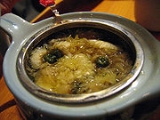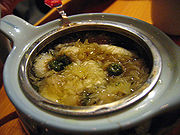
Chrysanthemum tea
Encyclopedia
Chrysanthemum tea is a flower-based tisane
made from chrysanthemum
flowers of the species Chrysanthemum morifolium or Chrysanthemum indicum, which are most popular in East Asia
. To prepare the tea, chrysanthemum flowers (usually dried) are steeped in hot water (usually 90 to 95 degrees Celsius after cooling from a boil) in either a teapot
, cup, or glass; often rock sugar
is also added, and occasionally also wolfberries
. The resulting drink is transparent and ranges from pale to bright yellow in color, with a floral aroma. In Chinese tradition, once a pot of chrysanthemum tea has been drunk, hot water is typically added again to the flowers in the pot (producing a tea that is slightly less strong); this process is often repeated several times. Chrysanthemum tea was first drunk during the Song Dynasty
(960–1279).
The flower is called gek huay in Thai. In Tamil it is called saamandhi.
Of these, the first two are most popular. Some varieties feature a prominent yellow flower head
while others do not.
 Chrysanthemum tea has many purported medicinal uses, including an aid in recovery from influenza
Chrysanthemum tea has many purported medicinal uses, including an aid in recovery from influenza
, acne
and as a "cooling" herb. According to traditional Chinese medicine
the tea can aid in the prevention of sore throat
and promote the reduction of fever
. In Korea, it is known well for its medicinal use for making people more alert and is often used as a pick-me-up to render the drinker more awake. In western herbal medicine, Chrysanthemum tea is drunk or used as a compress to treat circulatory disorders such as varicose veins
and atherosclerosis
.
In traditional Chinese medicine, chrysanthemum tea is also said to clear the liver and the eyes. It is believed to be effective in treating eye pain associated with stress or yin/fluid deficiency. It is also used to treat blurring, spots in front of the eyes, diminished vision, and dizziness. The liver is associated with the element Wood which rules the eyes and is associated with anger, stress, and related emotions.
outside Asia in canned or packed form. Due to its medicinal value, it may also be available at Traditional Chinese medicine
outlets, often mixed with other ingredients.
Tisane
A herbal tea, tisane, or ptisan is a herbal or plant infusion and usually not made from the leaves of the tea bush . Typically, herbal tea is simply the combination of boiling water and dried fruits, flowers or herbs. Herbal tea has been imbibed for nearly as long as written history extends...
made from chrysanthemum
Chrysanthemum
Chrysanthemums, often called mums or chrysanths, are of the genus constituting approximately 30 species of perennial flowering plants in the family Asteraceae which is native to Asia and northeastern Europe.-Etymology:...
flowers of the species Chrysanthemum morifolium or Chrysanthemum indicum, which are most popular in East Asia
East Asia
East Asia or Eastern Asia is a subregion of Asia that can be defined in either geographical or cultural terms...
. To prepare the tea, chrysanthemum flowers (usually dried) are steeped in hot water (usually 90 to 95 degrees Celsius after cooling from a boil) in either a teapot
Teapot
A teapot is a vessel used for steeping tea leaves or a herbal mix in near-boiling water. Tea may be either in a tea bag or loose, in which case a tea strainer will be needed, either to hold the leaves as they steep or to catch the leaves inside the teapot when the tea is poured...
, cup, or glass; often rock sugar
Rock candy
Rock candy is a type of confectionery mineral composed of relatively large sugar crystals. This candy is formed by allowing a supersaturated solution of sugar and water to crystallize onto a surface suitable for crystal nucleation, such as a string or stick...
is also added, and occasionally also wolfberries
Wolfberry
Wolfberry, commercially called goji berry, is the common name for the fruit of two very closely related species: Lycium barbarum and L. chinense , two species of boxthorn in the family Solanaceae...
. The resulting drink is transparent and ranges from pale to bright yellow in color, with a floral aroma. In Chinese tradition, once a pot of chrysanthemum tea has been drunk, hot water is typically added again to the flowers in the pot (producing a tea that is slightly less strong); this process is often repeated several times. Chrysanthemum tea was first drunk during the Song Dynasty
Song Dynasty
The Song Dynasty was a ruling dynasty in China between 960 and 1279; it succeeded the Five Dynasties and Ten Kingdoms Period, and was followed by the Yuan Dynasty. It was the first government in world history to issue banknotes or paper money, and the first Chinese government to establish a...
(960–1279).
Varieties
Several varieties of chrysanthemum, ranging from white to pale or bright yellow in color, are used for tea. These include:- Huángshān Gòngjú (黄山贡菊, literally "Yellow Mountain tribute chrysanthemum"); also called simply Gòngjú (贡菊)
- Hángbáijú (杭白菊), originating from TongxiangTongxiangTongxiang City is a county-level city, part of Jiaxing , in northern Zhejiang Province, China. Population : 109,976.The scenic town of Wuzhen is part of Tongxiang....
, near HangzhouHangzhouHangzhou , formerly transliterated as Hangchow, is the capital and largest city of Zhejiang Province in Eastern China. Governed as a sub-provincial city, and as of 2010, its entire administrative division or prefecture had a registered population of 8.7 million people...
; also called simply Hángjú, (杭菊) - Chújú (滁菊), originating from the ChuzhouChuzhouChuzhou is a prefecture-level city in eastern Anhui Province, People's Republic of China. It borders the provincial capital of Hefei to the southwest, Huainan to the west, Bengbu to the northwest, Chaohu to the south, and the province of Jiangsu to the east...
district of AnhuiAnhuiAnhui is a province in the People's Republic of China. Located in eastern China across the basins of the Yangtze River and the Huai River, it borders Jiangsu to the east, Zhejiang to the southeast, Jiangxi to the south, Hubei to the southwest, Henan to the northwest, and Shandong for a tiny... - Bójú (亳菊), originating in the BozhouBozhouBozhou is a prefecture-level city in northwestern Anhui province, People's Republic of China. It borders Huaibei to the northeast, Bengbu to the southeast, Huainan to the south, Fuyang to the southwest, and the province of Henan to the north.-Administration:...
district of AnhuiAnhuiAnhui is a province in the People's Republic of China. Located in eastern China across the basins of the Yangtze River and the Huai River, it borders Jiangsu to the east, Zhejiang to the southeast, Jiangxi to the south, Hubei to the southwest, Henan to the northwest, and Shandong for a tiny...
The flower is called gek huay in Thai. In Tamil it is called saamandhi.
Of these, the first two are most popular. Some varieties feature a prominent yellow flower head
Head (botany)
The capitulum is considered the most derived form of inflorescence. Flower heads found outside Asteraceae show lesser degrees of specialization....
while others do not.
Medicinal use

Influenza
Influenza, commonly referred to as the flu, is an infectious disease caused by RNA viruses of the family Orthomyxoviridae , that affects birds and mammals...
, acne
Acne
Acne is a general term used for acneiform eruptions. It is usually used as a synonym for acne vulgaris, but may also refer to:*Acne aestivalis*Acne conglobata*Acne cosmetica*Acne fulminans*Acne keloidalis nuchae*Acne mechanica...
and as a "cooling" herb. According to traditional Chinese medicine
Traditional Chinese medicine
Traditional Chinese Medicine refers to a broad range of medicine practices sharing common theoretical concepts which have been developed in China and are based on a tradition of more than 2,000 years, including various forms of herbal medicine, acupuncture, massage , exercise , and dietary therapy...
the tea can aid in the prevention of sore throat
Sore throat
A sore throat or throat pain is a common physical symptom usually caused by acute pharyngitis, or throat inflammation, though it also occurs in a number of other situations, such as post trauma and in diphtheria. It can cause mild to extreme pain....
and promote the reduction of fever
Fever
Fever is a common medical sign characterized by an elevation of temperature above the normal range of due to an increase in the body temperature regulatory set-point. This increase in set-point triggers increased muscle tone and shivering.As a person's temperature increases, there is, in...
. In Korea, it is known well for its medicinal use for making people more alert and is often used as a pick-me-up to render the drinker more awake. In western herbal medicine, Chrysanthemum tea is drunk or used as a compress to treat circulatory disorders such as varicose veins
Varicose veins
Varicose veins are veins that have become enlarged and tortuous. The term commonly refers to the veins on the leg, although varicose veins can occur elsewhere. Veins have leaflet valves to prevent blood from flowing backwards . Leg muscles pump the veins to return blood to the heart, against the...
and atherosclerosis
Atherosclerosis
Atherosclerosis is a condition in which an artery wall thickens as a result of the accumulation of fatty materials such as cholesterol...
.
In traditional Chinese medicine, chrysanthemum tea is also said to clear the liver and the eyes. It is believed to be effective in treating eye pain associated with stress or yin/fluid deficiency. It is also used to treat blurring, spots in front of the eyes, diminished vision, and dizziness. The liver is associated with the element Wood which rules the eyes and is associated with anger, stress, and related emotions.
Commercially available chrysanthemum tea
Although typically prepared at home, chrysanthemum tea is also available as a beverage in many Asian restaurants (particularly Chinese ones), and is also available from various drinks outlets in East Asia as well as Asian grocery storesAsian supermarket
An Asian supermarket, sometimes called an "Oriental supermarket", is a grocery store in non-Asian countries that stocks items imported from the many countries in East and Southeast Asia. They carry items and ingredients generally well-suited for Asian cuisines and not found in most Western...
outside Asia in canned or packed form. Due to its medicinal value, it may also be available at Traditional Chinese medicine
Traditional Chinese medicine
Traditional Chinese Medicine refers to a broad range of medicine practices sharing common theoretical concepts which have been developed in China and are based on a tradition of more than 2,000 years, including various forms of herbal medicine, acupuncture, massage , exercise , and dietary therapy...
outlets, often mixed with other ingredients.

